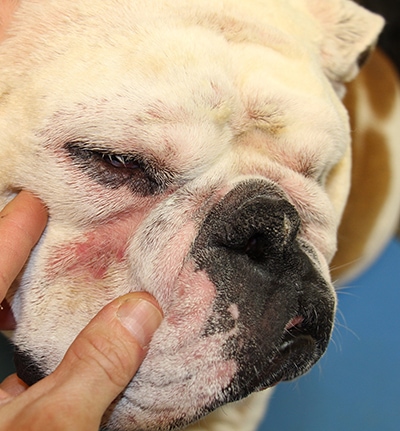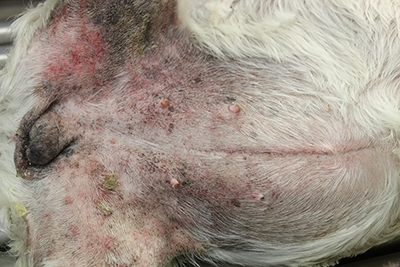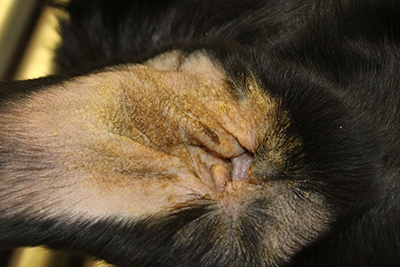How to properly care for your dog’s or cat’s coat?
Author: JL Mathet
Introduction
The care of the skin and coat of our domestic carnivores is essential for their health, aesthetic appearance, and to limit the development of skin diseases (dermatoses). It involves regular mechanical care (brushing, clipping, cleaning), the use of cosmetic products, topicals and a quality, adapted diet.
The skin is the body’s largest organ, constituting a fundamental anatomical and physiological barrier, the cutaneous barrier, between the external environment and the internal milieu. It reflects the physiological state of the entire organism and helps maintain its biochemical and thermal homeostasis (that is, balance). From the surface to the depth, it is composed of the epidermis, dermis, epidermal appendages (hair follicles, sebaceous and sweat glands, and finally the nails or claws), hypodermis, and the cutaneous muscle. This barrier is effective against external aggressions (climate, microbes, allergens, toxins, trauma), being both impermeable and protective, while regulating exchanges, especially of water, between the organism and the environment.
Its thickness varies from 0.5 to 5mm in dogs and varies according to the area of the body, the breed, and even health status (underlying diseases, deficiencies). It is thicker on the back, thinner in the ventral region and at the end parts of the limbs.
Local care and topical treatments
Skin lesions are directly accessible to the active principles of topicals, and their benefits are multiple:
direct application of the medication hence increased and rapid action
reduction in the risk of side effects (no general circulation)
lower treatment cost (fewer pills)
increased owner involvement in the care of their pet
Goals : soothe, hydrate, protect, treat and not to forget prevent relapses!
Depending on the species, breed, lifestyle, and use of their pet, coat care will not have the same meaning or modalities. A Shih Tzu dog in an urban setting participating in shows will require frequent shampoos, brushings, and groomings. Conversely, a hunting dog living in a kennel or countryside will benefit more simply from occasional washes. The practical ability and availability of each owner are also factors of variability.
The presentations are multiple: shampoos, ointments, gels, emulsions, sprays, wipes, impregnated disks (pads), eye drops, rinsing lotions, foams, pipettes (spot-on). Each of these must be adapted to the coat, the dermatosis, the application possibilities, and of course the owner!
There are active agents against infections, against itching (pruritus), to control skin allergies (inflammation), for bad coat odours (seborrheas), for ‘dandruff’ (scales), against ectoparasites (fleas, mites), against ear infections and for periocular care.
Washing
As a first step, shampoos can be used throughout the year at regular intervals, with quality products suitable for the dog’s (or cat’s) skin. Criteria to favour are foaming power, cleansing, beautifying effect (shine, hydration), as well as high tolerance.
Their frequency is to be adapted based on what is expected from their action, the animal’s environment, health condition, and coat. When a skin disease is present, shampoos may be bi-weekly or even daily at first, then spaced to two or three times a month according to the clinical response.
The practical methods for performing shampoos are detailed in the specific tab on the site’s homepage.
Regular hygiene care
These concern the cleaning of moist areas such as folds, periocular, perigenital, perianal regions, ears, and regions of repeated friction (withers, groins).

The interdigital spaces and pads should be often examined to remove any foreign bodies (awns, thorns, matted hair balls, gravel). Long hair can be advantageously cut or clipped to limit the risk of snagging foreign plant bodies.
The eyes and eyelids should be regularly maintained with suitable ocular lotions or physiological serum. The inner corner of the eyes is often the site of discharge from tear secretions, giving unsightly brownish streaks on a light or white coat. This discolouration corresponds to an oxidation reaction in the air and can be limited with frequent rinsing with suitable solutions. Some breeds with long coats may develop ocular irritations from hair rubbing on the cornea: they should be delicately cut when necessary.
The lips are sometimes the site of maceration due to humidity from saliva, the presence of food residues, and sometimes from folds along the lips. Regular cleaning and sometimes disinfection can reduce the onset of painful dermatoses for the animal and complicated management.
The perianal area, vulvar folds, and sheath can also be delicately and regularly groomed. This is important in overweight animals where the folds can become sites of unpleasant and smelly inflammation and infection. Here again, simple but frequent hygiene limits their persistence.
Note that the yellowish secretions sometimes observed at the tip of a male’s penis are generally not pathological, but a sign of an irritation of the penile mucosa. This is called balanoposthitis, and simple dry wiping is enough to limit discharges.
Wipes and disks (pads) are particularly suited for fold areas, cutaneous-mucosal regions (eyes, lips, anal or genital area), as well as large hairless surfaces. Certain breeds such as molossoids (Bulldogs, Pugs, Shar-Pei…) are characterized by very developed wrinkled regions and are sensitive to maceration and secondary infections (bacterial, yeast). The wipes are impregnated with disinfectant and soothing molecules adapted to these complications.
Sprays are suitable for treating large areas or for animals resistant to prolonged contact. Indeed, once sprayed, no massage is necessary. Again, there are many presentations with antiseptic, emollient, anti-inflammatory, or anti-seborrheic active ingredients.
Foams are pleasant to use, their texture and perfumes make them comfortable products to use, and the dose to be delivered is more adaptable. They can be generously applied to the palm of the hand or on a washcloth, then evenly distributed again on hairless or pre-clipped skin regions.

Cutaneous application pipettes (spot-on) allow rapid distribution over specific areas to be treated or more generally along the back line of hydrating, emollient, antiseptic, and anti-seborrheic products. Just press the content onto the skin by parting the coat and let it act.
Ear care
Cleaning your animal’s ears involves knowing their anatomical and physiological characteristics. A dog’s ear consists of an external part – the auricle – of variable size, standing or drooping, more or less hairy depending on the breed, and an internal part, the auditory canal, which is bent into two sections, one vertical from its entry then horizontal to the eardrum.
The secretions naturally produced (cerumen) or secondary to infectious diseases, as well as substances introduced into the auditory canal, tend to accumulate in the deep (horizontal) portion and stagnate and macerate there. Cerumen is a specific sebum produced by specialized glands (sebaceous, sweat) of the canal. Any disturbance of the ear’s microenvironment leads to the formation of abnormal cerumen in quality and quantity (composition, texture). These disturbances can be induced by internal factors (racial criteria, allergic, infectious, or hormonal diseases) or external (parasites, irritant agents, excessive humidity).
To avoid any risk of otitis, which is inflammation of the auditory canal and/or eardrum, ear washing precautions must be respected and appropriate cleaning active principles used.

Method
Ideally, it is useful to be two people when performing a proper care, especially in the case of a painful otitis or a recalcitrant animal, in order to hold the animal and avoid sudden head movements. The cleaning lotion is gently introduced into each canal to fill it, then the canal is gently massaged. The dog is then allowed to shake, after which the flap and the entrance of the canal are dried with a piece of cotton (tissue, paper towels) to remove the excess dirt. The operation can be repeated a second time if the ear is particularly dirty.
This cleaning is a necessary step before applying any treatment with an ear drop as it “prepares” the ear canals for the optimal action of the active ingredients. Wipes and impregnated pads also allow for the effective cleaning of the flaps on their entire surface. Under no circumstances should cotton swabs be used as they risk pushing debris to the back of the canal instead of extracting them, and might even injure the animal.
In certain cases, the ear canals can be partially plucked with a specific tool, without excess and without being traumatic, and the internal surfaces of the flaps can be clipped with a small trimmer. This is particularly indicated in breeds with abundant fur (Cocker Spaniels), or curly hair (Poodles, Bichons), as well as in cases of hypertrichosis.
Brushing and clipping the coat
Brushing and combing the coat of your dog or cat is an essential part of its care. These actions help remove debris, dead hair, and allow the coat to shine. They need to be frequent, especially during heavy moults (see article on the skin and coat of dogs and cats), or for long and thick hair. Some fine-toothed combs can catch fleas or their droppings. There is a wide range of equipment available, from simple combs to sophisticated gloves or brushes: do not hesitate to seek advice from groomers or specialised stores.
Professional grooming is often necessary for complex coats or for reasons of standard and aesthetics. Groomers are there to guide you and provide quality work, at a frequency varying according to the breed and your preferences, from once to several times a year. Stripping is sometimes recommended, as with certain Terriers, it helps remove dead hair and regrowth from previous strips except the last one. It is not a painful act but should not be performed during inflammatory or infectious dermatoses, to avoid worsening the skin condition.
Place of nutrition
Many nutrient deficiencies result in skin diseases, especially because the skin is an extensive organ with a rapid renewal of its cells. In cases of deficient dietary intake, this renewal is accelerated up to 3 or 4 days, leading to the formation of flakes (“dandruff”) and an abnormal surface lipid film: these are the dry or greasy seborrheas. Of course, other factors (hormones, drugs, internal, genetic, environmental diseases) influence skin health, but nutrition is fundamental for maintaining an effective skin barrier.
Low-quality foods like low-end kibble, excess cereals or calcium, an unbalanced homemade diet prevent proper absorption of zinc and are at the origin of severe nutritional dermatoses deficiencies. A diet containing, among other things, and in a balanced manner, essential fatty acids (w3, w6), zinc, copper, and vitamins (A, B6, H, B2, B3) as well as sulfur amino acids is therefore necessary to ensure the quality of the coat and skin covering.
Conclusion
The skin care of your pet requires simple, but appropriate and regular, treatments thanks to the use of quality dermo-cosmetic products. The hygiene of the dog’s and cat’s skin is not only a comfort of life for them but also a guarantee for you, the owner, to limit the risk of disease or parasite transmission. Your veterinarian will advise you in the choice of topicals and their active ingredients according to your expectations and the specificity of the coat and breed of your dog or cat.